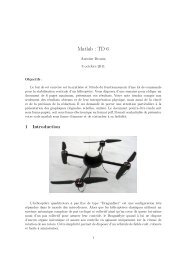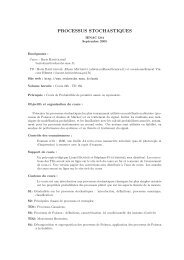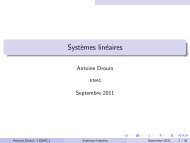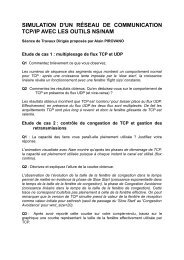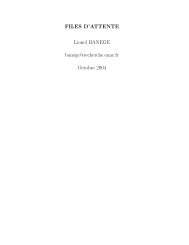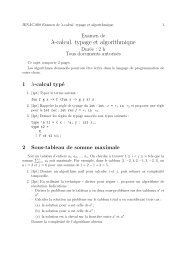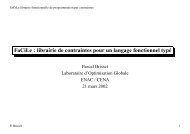Réalisation de la représentation d'état - La Recherche - ENAC
Réalisation de la représentation d'état - La Recherche - ENAC
Réalisation de la représentation d'état - La Recherche - ENAC
Create successful ePaper yourself
Turn your PDF publications into a flip-book with our unique Google optimized e-Paper software.
Exponentielle <strong>de</strong> matricesProduit d’exponentielles :e (A+B)x (A + B)2= I + (A + B)x + x 2 + · · ·2e Ax e Bx =(I + Ax + A2 x 2 )+ · · ·(I + Bx + B2 x 2 )+ · · ·22= I + (A + B)x + A2 x 2+ ABx 2 + B2 x 2+ · · ·22e (A+B)x − e Ax e Bx = (BA − AB) x 2e (A+B)x = e Ax e Bx ⇔ AB = BA2 + · · ·Antoine Drouin, Félix Mora Camino ( <strong>ENAC</strong> ) <strong>Réalisation</strong> <strong>de</strong> <strong>la</strong> <strong>représentation</strong> d’état Septembre 2009 2 / 23
<strong>Réalisation</strong> <strong>de</strong> <strong>la</strong> <strong>représentation</strong> d’étatAntoine Drouin, Félix Mora Camino<strong>ENAC</strong>Septembre 2009Antoine Drouin, Félix Mora Camino ( <strong>ENAC</strong> ) <strong>Réalisation</strong> <strong>de</strong> <strong>la</strong> <strong>représentation</strong> d’état Septembre 2009 3 / 23
1 Introduction2 Formes Diagonales3 Formes CompagnesAntoine Drouin, Félix Mora Camino ( <strong>ENAC</strong> ) <strong>Réalisation</strong> <strong>de</strong> <strong>la</strong> <strong>représentation</strong> d’état Septembre 2009 4 / 23
IntroductionIntroduction<strong>La</strong> multiplicité <strong>de</strong>s <strong>représentation</strong>s d’état est un avantage.Permet le choix d’une <strong>représentation</strong> adaptée au type <strong>de</strong> problème.Formes canoniques.Évolution du système, retour d’état, observateurA diagonale / quasi diagonaleA formes “compagne”Commandabilité, ObservabilitéForme <strong>de</strong> B et CAntoine Drouin, Félix Mora Camino ( <strong>ENAC</strong> ) <strong>Réalisation</strong> <strong>de</strong> <strong>la</strong> <strong>représentation</strong> d’état Septembre 2009 5 / 23
IntroductionChangement <strong>de</strong> <strong>représentation</strong> :Pluralité <strong>de</strong> <strong>la</strong> <strong>représentation</strong> d’étatChangement <strong>de</strong> variable X = M ˜X avec M matrice régulièreM ˙˜X = AM ˜X + BU˙˜X = M −1 AM ˜X + M −1 BUY = CM ˜X + DUÃ = M −1 AM ˜B = M −1 B ˜C = CMRemarque :˜C ˜B = CMM −1 B = CBLe produit CB est un invariant <strong>de</strong> l’ensemble <strong>de</strong>s <strong>représentation</strong> d’état.Antoine Drouin, Félix Mora Camino ( <strong>ENAC</strong> ) <strong>Réalisation</strong> <strong>de</strong> <strong>la</strong> <strong>représentation</strong> d’état Septembre 2009 6 / 23
Formes DiagonalesFormes diagonalesMise en évi<strong>de</strong>nce <strong>de</strong>s mo<strong>de</strong>s.Mo<strong>de</strong>s d’un système linéaire : pôles <strong>de</strong> sa fonction <strong>de</strong> transfertMo<strong>de</strong>s d’un système linéaire : valeurs propres <strong>de</strong> sa matriced’évolutionAntoine Drouin, Félix Mora Camino ( <strong>ENAC</strong> ) <strong>Réalisation</strong> <strong>de</strong> <strong>la</strong> <strong>représentation</strong> d’état Septembre 2009 7 / 23
Formes DiagonalesForme diagonaleSi toutes les valeurs propres sont disctinctes, A peut être mise sous formediagonale par <strong>la</strong> transformation :Ã d = P −1 AP = Λoù P est <strong>la</strong> matrice <strong>de</strong>s vecteurs propres <strong>de</strong> A.⎛⎞λ 1 0 · · · · · · · · · 0. 0 λ .. 2 .. . .. . λ3 .. .Ã d = Λ =. . .. . .. . .. .⎜⎝. ⎟... λn−1 0 ⎠0 · · · · · · · · · 0 λ nAntoine Drouin, Félix Mora Camino ( <strong>ENAC</strong> ) <strong>Réalisation</strong> <strong>de</strong> <strong>la</strong> <strong>représentation</strong> d’état Septembre 2009 8 / 23
Formes DiagonalesExemple 1⎛−1 1⎞0⎛1⎞0A = ⎝ 0 0 0 ⎠ B = ⎝0 1⎠1 0 −30 1( ) 1 0 0C =D = ( 0 )0 1 1Antoine Drouin, Félix Mora Camino ( <strong>ENAC</strong> ) <strong>Réalisation</strong> <strong>de</strong> <strong>la</strong> <strong>représentation</strong> d’état Septembre 2009 9 / 23
Formes DiagonalesForme quasi diagonale <strong>de</strong> JordanSi le polynôme caractéristique est scindé, A peut ètre mise sous formequasi diagonale.λ k : valeur propre multiple d’ordre n.r : nb <strong>de</strong> vecteurs propres indépendants associés à λ k .q = n − r : dégénérescence <strong>de</strong> λ k .Bloc <strong>de</strong> Jordan⎛⎞λ k 1 0 · · · · · · 0. 0 λ k 1 .. .. . .. . .. . .. . .. .J(λ k ) =. . .. . .. . .. 0⎜⎝.... . ⎟ .. 1 ⎠0 · · · · · · · · · 0 λ kAntoine Drouin, Félix Mora Camino ( <strong>ENAC</strong> ) <strong>Réalisation</strong> <strong>de</strong> <strong>la</strong> <strong>représentation</strong> d’état Septembre 2009 10 / 23
Formes DiagonalesForme quasi diagonale <strong>de</strong> Jordan (cont)On montre que J d et J n commutente tJ(λk) = e tJ d (λ k )+tJ n(λ k ) = e tJ d (λ k ) e tJn(λ k)⎛⎞t⎛e tλ ⎞ 1 t 2 tk 2· · · p−1(p−1)!0e tJ(λk) 0 e tλ k0. 0 .. . .. . .. .=⎜⎟.⎝ 0 0 ⎠. .. . .. tt 2 2⎜0 e tλ ⎝ .k . 0 .. . ⎟.. t ⎠0 · · · · · · 0 1Antoine Drouin, Félix Mora Camino ( <strong>ENAC</strong> ) <strong>Réalisation</strong> <strong>de</strong> <strong>la</strong> <strong>représentation</strong> d’état Septembre 2009 12 / 23
Formes DiagonalesExemple 2Calculez <strong>la</strong> trajectoire du système LTI libre ayant <strong>la</strong> matrice <strong>de</strong> dynamiquesuivante :⎛5 −1⎞0A = ⎝1 3 0⎠0 0 2Antoine Drouin, Félix Mora Camino ( <strong>ENAC</strong> ) <strong>Réalisation</strong> <strong>de</strong> <strong>la</strong> <strong>représentation</strong> d’état Septembre 2009 13 / 23
Formes DiagonalesCas <strong>de</strong>s valeurs propres complexesConsidérons le cas d’une matrice A <strong>de</strong> dimension 3 dont 2 valeurs propressont complexes conjuguées :λ 1 = σ + jω λ 2 = σ − jω λ 3 ∈ RNous savons qu’A peut être diagonalisée :⎛⎞σ + jω 0 0Ã = Λ = ⎝ 0 σ − jω 0 ⎠0 0 λ 3Antoine Drouin, Félix Mora Camino ( <strong>ENAC</strong> ) <strong>Réalisation</strong> <strong>de</strong> <strong>la</strong> <strong>représentation</strong> d’état Septembre 2009 14 / 23
Formes DiagonalesCas <strong>de</strong>s valeurs propres complexesΛ peut être transformée en une matrice Λ 2 à coéfficients réels⎛ ⎞σ ω 0Λ 2 = ⎝−ω σ 0 ⎠ = K −1 ΛK0 0 λ 3à l’ai<strong>de</strong> <strong>de</strong> <strong>la</strong> transformation⎛ ⎞12−j20K = ⎝ 1 j2 20⎠0 0 1Antoine Drouin, Félix Mora Camino ( <strong>ENAC</strong> ) <strong>Réalisation</strong> <strong>de</strong> <strong>la</strong> <strong>représentation</strong> d’état Septembre 2009 15 / 23
Formes CompagnesFormes CompagnesPolynôme caractéristique <strong>de</strong> A∆(λ) = <strong>de</strong>t(λI − A) = λ n + a n−1 λ n−1 + · · · + a 1 λ + a 0On définit <strong>de</strong>ux formes compagnes, construites à partir <strong>de</strong>s coefficients dupolynôme caractéristique <strong>de</strong> A.Antoine Drouin, Félix Mora Camino ( <strong>ENAC</strong> ) <strong>Réalisation</strong> <strong>de</strong> <strong>la</strong> <strong>représentation</strong> d’état Septembre 2009 16 / 23
Formes CompagnesForme Compagne <strong>de</strong> comman<strong>de</strong>⎛⎞0 10 1 0Ã c =0 1⎜ 0 0 1⎟⎝0 1 ⎠−a 0 −a 1 −a 2 · · · · · · −a n−1Antoine Drouin, Félix Mora Camino ( <strong>ENAC</strong> ) <strong>Réalisation</strong> <strong>de</strong> <strong>la</strong> <strong>représentation</strong> d’état Septembre 2009 17 / 23
Formes CompagnesForme Compagne <strong>de</strong> comman<strong>de</strong><strong>La</strong> matrice <strong>de</strong> transformation est telle que :Ã c = P −1 AP ou PÃ c = APEn notant p 1 , p 2 , · · · , p n les colonnes <strong>de</strong> P(p1 p 2 · · · p n)Ãc = A ( p 1 p 2 · · · p n)d’oùp n−1 = [A + a n−1 I]p np n−2 = [A 2 + a n−1 A + a n−2 I]p n· · ·p 1 = [A n−1 + a n−1 A n−2 + · · · + a 1 I]p nAntoine Drouin, Félix Mora Camino ( <strong>ENAC</strong> ) <strong>Réalisation</strong> <strong>de</strong> <strong>la</strong> <strong>représentation</strong> d’état Septembre 2009 18 / 23
Formes CompagnesForme Compagne <strong>de</strong> comman<strong>de</strong>P est complètement définie à partir du choix <strong>de</strong> p nSeule contrainte : P doit être non singulièreDans le cas d’un système mono-entrée, un bon choix est p n = BDans ce cas ˜B = ( 0 0 · · · 1 ) , ce qui est interessant pour étudier<strong>la</strong> manière dont <strong>la</strong> comman<strong>de</strong> se propage dans le système.Antoine Drouin, Félix Mora Camino ( <strong>ENAC</strong> ) <strong>Réalisation</strong> <strong>de</strong> <strong>la</strong> <strong>représentation</strong> d’état Septembre 2009 19 / 23
Formes CompagnesForme Compagne d’observation⎛−a n−1 1Ã o =⎜⎝· · · 0 1 0· · · 0 1−a 2 0 1−a 1 0 0 1−a 0 0⎞⎟⎠Antoine Drouin, Félix Mora Camino ( <strong>ENAC</strong> ) <strong>Réalisation</strong> <strong>de</strong> <strong>la</strong> <strong>représentation</strong> d’état Septembre 2009 20 / 23
Formes Compagnes<strong>La</strong> matrice <strong>de</strong> transformation est telle que :Forme Compagne d’observationà o = P −1 AP ou P −1 A = à o P −1En posant M = (P −1 ) T on obtient A T M = Mà oTEn notant m 1 , m 2 , · · · , m n les colonnes <strong>de</strong> Md’oùA T ( m 1 m 2 · · · m n)=(m1 m 2 · · · m n)ÃoTm 2 = [A T + a n−1 I]m 1m 3 = [(A T ) 2 + a n−1 A T + a n−2 I]m 1· · ·m n = [(A T ) n−1 + a n−1 (A T )n − 2 + · · · + a 1 I]m 1Antoine Drouin, Félix Mora Camino ( <strong>ENAC</strong> ) <strong>Réalisation</strong> <strong>de</strong> <strong>la</strong> <strong>représentation</strong> d’état Septembre 2009 21 / 23
Formes CompagnesForme Compagne d’observationM ( donc P) est complètement définie à partir du choix <strong>de</strong> m 1Seule contrainte : M doit être non singulière ( oum 1 , A T m 1 , · · · , (A T ) (n−1) m 1 linéairement indépendants ).Dans le cas d’un système mono-sortie, un bon choix est m 1 = C TDans ce cas ˜C = ( 1 0 · · · 0 ) , ce qui est interessant pour étudier<strong>la</strong> re<strong>la</strong>tion entre l’état du système et <strong>la</strong> sortie.Antoine Drouin, Félix Mora Camino ( <strong>ENAC</strong> ) <strong>Réalisation</strong> <strong>de</strong> <strong>la</strong> <strong>représentation</strong> d’état Septembre 2009 22 / 23
Formes CompagnesAntoine Drouin, Félix Mora Camino ( <strong>ENAC</strong> ) <strong>Réalisation</strong> <strong>de</strong> <strong>la</strong> <strong>représentation</strong> d’état Septembre 2009 23 / 23






